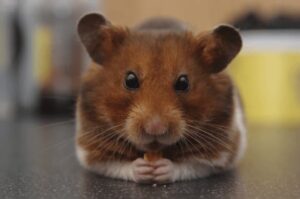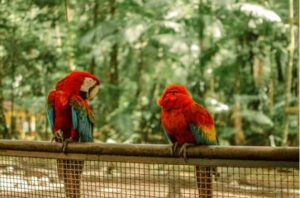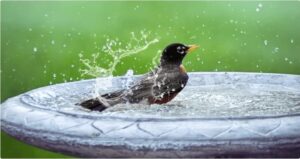Red birds are among the most stunning and recognizable birds in the world. Their vibrant plumage stands out in forests, gardens, and urban settings, making them a favorite among birdwatchers and nature enthusiasts. But what makes these birds red? Their striking color comes from carotenoid pigments found in their diet. Let’s explore some of the most popular red bird species and learn more about their fascinating lives.
Popular Red Bird Species
1. Northern Cardinal (Cardinalis cardinalis)

One of the most well-known red birds, the Northern Cardinal is native to North America. Males display bright red feathers with a distinctive black mask around their beak, while females have a more subdued brownish-red coloration. Cardinals are non-migratory birds and are often found in woodlands, gardens, and shrublands. Their melodious songs make them a favorite among bird lovers.
2. Scarlet Macaw (Ara macao)

The Scarlet Macaw is a large and vibrant parrot species found in Central and South America. Its bright red feathers are complemented by striking blue and yellow wings. These intelligent birds are social and are known for their strong beaks, which help them crack open nuts and seeds. Scarlet Macaws are often seen in tropical rainforests and are a symbol of exotic wildlife.
3. Vermilion Flycatcher (Pyrocephalus obscurus)

This small but stunning bird is native to the Americas, particularly in the southwestern United States, Mexico, and parts of South America. Males are known for their bright red plumage, while females have a more subdued brownish appearance. Vermilion Flycatchers are agile hunters, catching insects mid-air with their quick reflexes.
4. Summer Tanager (Piranga rubra)

The Summer Tanager is a medium-sized songbird found in North and Central America. Males are entirely red, while females display a more yellowish hue. These birds are skilled insect hunters, often feeding on bees and wasps. They migrate to Central and South America during the winter months.
5. Pine Grosbeak (Pinicola enucleator)

A member of the finch family, the Pine Grosbeak is found in the northern forests of North America, Europe, and Asia. Males have a striking red body, while females and juveniles have a more orange-yellow coloration. These birds primarily feed on fruits, seeds, and buds, making them an essential part of their ecosystem.
6. Red Avadavat (Amandava amandava)

Also known as the Strawberry Finch, the Red Avadavat is a small, brightly colored bird native to South and Southeast Asia. Males exhibit deep red plumage with white speckles during the breeding season, while females remain brownish throughout the year. They are often found in grasslands and agricultural fields.
7. Crimson Rosella (Platycercus elegans)

Native to Australia, the Crimson Rosella is a striking parrot species with deep red plumage and blue wing markings. These birds are commonly found in forests, woodlands, and even suburban gardens. They are known for their playful nature and can mimic sounds and whistles.
8. Red Crossbill (Loxia curvirostra)

The Red Crossbill is a fascinating bird known for its unique crossed beak, which it uses to extract seeds from pinecones. Males have red plumage, while females are more olive or yellowish. These birds are found in coniferous forests across North America, Europe, and Asia.
9. Hepatic Tanager (Piranga flava)
The Hepatic Tanager is a medium-sized songbird found in the southwestern United States, Mexico, and parts of Central and South America. Males have a reddish-orange hue, while females are more yellowish. These birds thrive in pine-oak woodlands and are known for their melodious calls.
10. Scarlet Tanager (Piranga olivacea)
Scarlet Tanagers are striking birds with bright red bodies and contrasting black wings. They breed in North America and migrate to South America during the winter. Despite their brilliant colors, they can be difficult to spot due to their preference for staying high in tree canopies.
Habitat and Distribution
Red birds inhabit a variety of ecosystems, from dense forests to open grasslands and urban parks. While species like the Northern Cardinal prefer suburban gardens, others like the Scarlet Tanager are found deep in wooded areas. Migration patterns vary, with some species being year-round residents and others traveling long distances.
Diet and Feeding Habits
Red birds have diverse diets that mainly consist of:
- Seeds and grains
- Fruits and berries (rich in carotenoids, which enhance their red plumage)
- Insects and small invertebrates
- Nectar (for some species like the Scarlet Tanager)
Providing bird feeders with sunflower seeds, safflower seeds, and suet can help attract red birds to your backyard.
Breeding and Nesting Behaviors
During the breeding season, red birds exhibit fascinating courtship displays. Males often sing melodious songs and present food to attract mates. Nests are usually built in dense shrubs or tree branches, offering protection from predators. The eggs are typically speckled and incubated by the female while the male provides food.
Red Birds in Culture and Symbolism
Red birds hold deep cultural and symbolic significance across various traditions:
- Spirituality: Many people believe red birds, especially cardinals, are signs from loved ones who have passed away.
- Luck and Prosperity: In some cultures, spotting a red bird is considered a good omen.
- Love and Passion: Their red color is often associated with emotions like love and vitality.
Conservation Status and Threats
While many red bird species have stable populations, some face threats due to:
- Habitat Loss: Deforestation and urbanization reduce nesting and feeding grounds.
- Climate Change: Altered migration patterns and food availability affect survival rates.
- Predators and Invasive Species: Domestic cats, larger birds, and habitat changes pose risks.
Conservation efforts, such as protecting natural habitats and providing food sources, are essential to ensure the survival of these birds.
How to Attract Red Birds to Your Backyard
Want to see more red birds in your garden? Here’s how:
- Provide Food Sources: Install bird feeders with seeds and fruits.
- Create a Bird-Friendly Habitat: Plant native trees and shrubs for shelter.
- Supply Fresh Water: Birdbaths or small ponds attract birds year-round.
- Reduce Pesticide Use: Avoid harmful chemicals that may affect their food sources.
Interesting Facts About Red Birds
- The Northern Cardinal is the state bird of seven U.S. states.
- Some red birds, like the Red Crossbill, have specialized beaks adapted for unique feeding habits.
- The male Scarlet Tanager molts into a yellowish-green color in the fall before migration.
Conclusion
Red birds are truly remarkable creatures, adding beauty and vibrancy to nature. Whether you’re an avid birdwatcher or a casual observer, understanding their habits, habitats, and importance can enhance your appreciation for these stunning avians. By providing suitable environments and conserving natural habitats, we can ensure that future generations continue to enjoy the sight of these magnificent birds.











